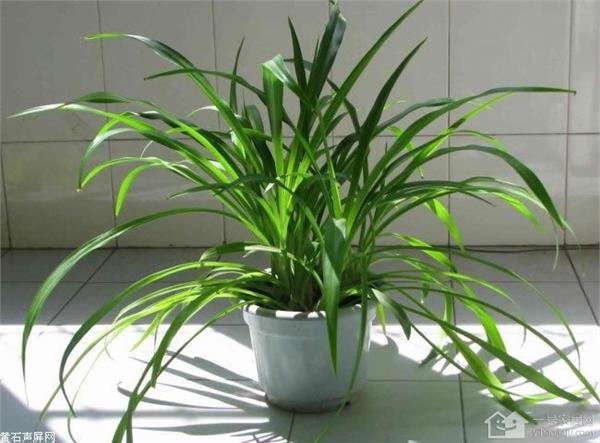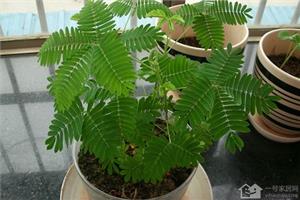The Culture method of Cymbidium what to do if the leaves turn yellow
Cymbidium, also known as weeping pot grass, laurel orchid, hook orchid, Magnolia, is a perennial evergreen herb of Liliaceae. Next, let's take a look at the planting and maintenance of Cymbidium.

Cymbidium is easy to breed and adaptable, and it is one of the most traditional indoor hanging plants. Its leaves are slender and soft, and small plants are drawn from the axils of the leaves, hanging from the basin, stretching and hanging, like flowers, evergreen all the year round. Cymbidium is the "king of formaldehyde removal" in plants.
The orchid can absorb more than 80% of the harmful gases in the room, and the ability to absorb formaldehyde is super. Ordinary rooms raise 2 pots of hanging orchids, which can absorb all the poisonous gases in the air. A pot of hanging orchids in a room of 10 square meters is equivalent to an air purifier, which can kill 80% of the harmful substances in the room within 24 hours; absorb 86% formaldehyde; and can absorb carbon monoxide and nitrogen peroxide emitted by stoves, electrical appliances and plastic products. Therefore, the hanging orchid is also known as the "green purifier".
There are many kinds of hanging orchids, each with different forms and characteristics. There are five common ones: such as orchids, purple orchids, flower orchids, gold leaf orchids, silver-edged orchids.
Cymbidium: the stem is not separated from the leaf, the leaf is drooping, the leaf is dark green, it blossoms in June or July every year, and the flowers are yellowish and white.
Purple hanging orchid: also known as color leaf orchid, the main vein of the leaf is purple, the branches are nodular, each node leaves, the leaves are thick and shiny, are drooping, blooming from June to October every year, the flower color is pink.
Flower orchid: the branches are trailing, the branches and leaves are drooping, the leaves are peach-shaped, the edges of the leaves are golden, and pass through the center of the veins, and the back of the leaves is purple and gives off light.
Phnom Penh orchid: on the green leaves, there are yellow lines around the leaves, which look especially good.
Silver-edged hanging orchid: green leaves, by white edge, more bright, watch up, more distinctive.
Golden orchid: the center of the leaf is yellow and longitudinally striped.
Cymbidium: there are silver-white longitudinal stripes around the main vein of the leaf.
Broad-leaf orchid: leaf blade broadly linear, entire or slightly wrinkled. Scape is extracted from the leaves and forms a creeping stem after flowering, which can take root and sprout and grow into a new plant in spring and summer. Capsule triangular-angled-oblate.
Middle spot orchid: leaves are long and narrow, lanceolate, milky white with green stripes and edges.
The culture method of Cymbidium:
[culture method] Cymbidium can be propagated by cutting, ramet, sowing and other methods. Cuttings and ramet propagation can be carried out at any time from spring to autumn. Cymbidium has strong adaptability and high survival rate, so it is generally easy to reproduce. When planting, as long as the stolon with new buds of 510 cm is inserted into the soil, it can take root in about a week, and it can be transplanted into a pot in about 20 days and watered thoroughly and maintained in a cool place.
First, temperature control. Cymbidium prefers warm and humid climate and is not resistant to cold. It grows fastest at 20-24 ℃ and stops growing at more than 30 ℃. The leaves are easy to turn yellow and dry.
Second, light adjustment. Outdoor cultivation in summer should pay attention to shade, so as not to make the light too strong, otherwise sunburn can easily occur.
Third, the regulation of water and fertilizer. Spring and autumn growth season, watering should be adequate, basin soil should always keep moist, and often spray branches and leaves with water close to room temperature, to prevent dry tip, but not stagnant water.
Fourth, trim and change the basin. As the plant grows, the old leaves at the base should be cut frequently in order to maintain a good plant shape.
Fifth, pest control. The dense plant clusters of Cymbidium are poorly ventilated and vulnerable to scale insects, so prevention should be given priority to.
What if the leaves of Cymbidium turn yellow?
The yellowing of the leaves during the growth of Cymbidium is caused by a variety of reasons.
First, there is too much fertilizer, which exceeds the requirement of the plant. At the beginning, the leaves were shiny and uneven, the roots rotted and the leaves were yellow. Should stop fertilizing, irrigate more water, or turn the pot to clean the root and replace the new soil.
Second, the basin has not been turned over for a long time. The various nutrient elements in the basin soil have been exhausted, the three elements of nitrogen, phosphorus and potassium have not been replenished in time, the plant is lack of nutrients, and the leaves are yellow and thin. Fertile loam and fertile water should be replaced in time.
Third, although the orchid is a semi-negative flower, at least four hours of astigmatism should be seen every day, otherwise the chlorophyll will decrease and the leaves will turn yellow.
Fourth, it is poor air permeability and water permeability of basin soil. The long-term accumulation of water in the basin soil makes it difficult for the root system to breathe, which leads to the yellowing of the leaves. The soil should be loosened and moisture should be controlled in time. Fifth, it is impervious to water for a long time. The roots of Cymbidium lose water, and the lower old leaves turn yellow. It should be watered thoroughly to keep the basin soil warm and moist.
If you want to know more about it, you can continue to follow the No.1 Home Network.
Related
- Wuhan Hospital Iron Tree Blooming Result Was Instantly Frightened by the Gardener Master
- Which variety of camellia is the most fragrant and best? Which one do you like best?
- What is the small blue coat, the breeding methods and matters needing attention of the succulent plant
- Dormancy time and maintenance management of succulent plants during dormancy
- Minas succulent how to raise, Minas succulent plant pictures
- What are the varieties of winter succulent plants
- How to raise succulent plants in twelve rolls? let's take a look at some experience of breeding twelve rolls.
- Attention should be paid to water control for succulent plants during dormant period (winter and summer)
- Watering experience of twelve rolls of succulent plants
- Techniques for fertilizing succulent plants. An article will let you know how to fertilize succulent plants.


